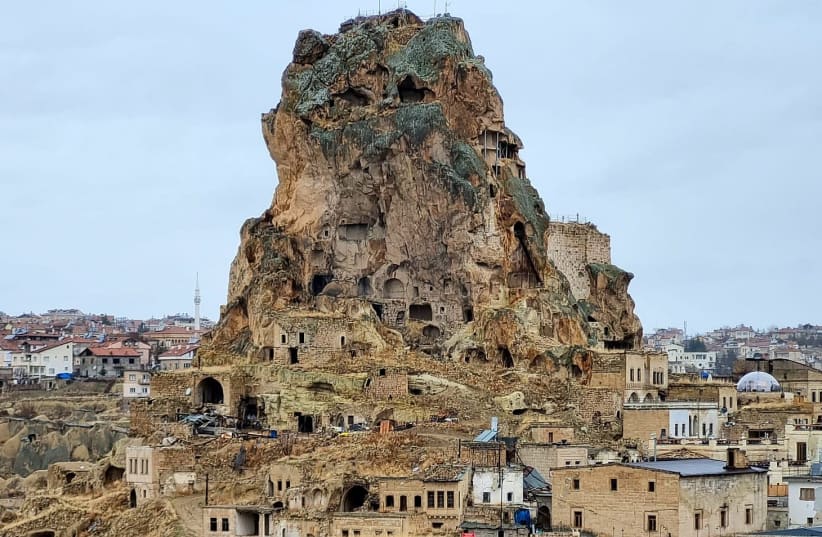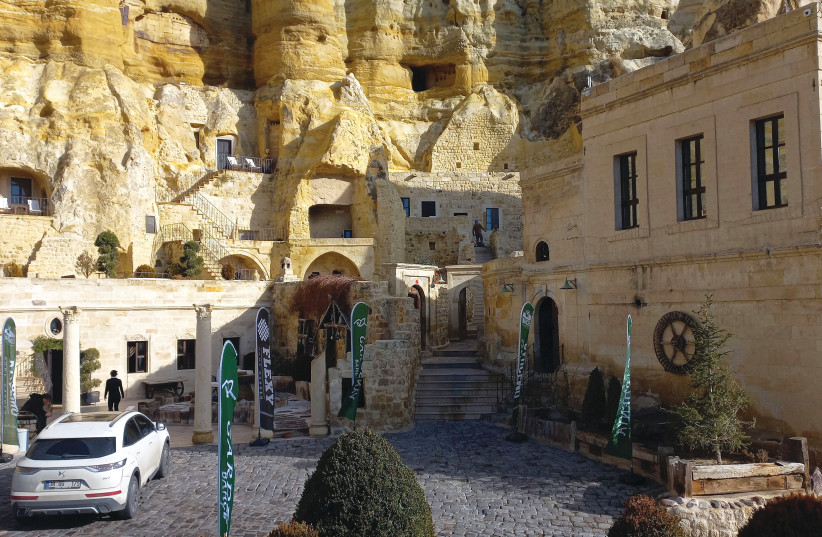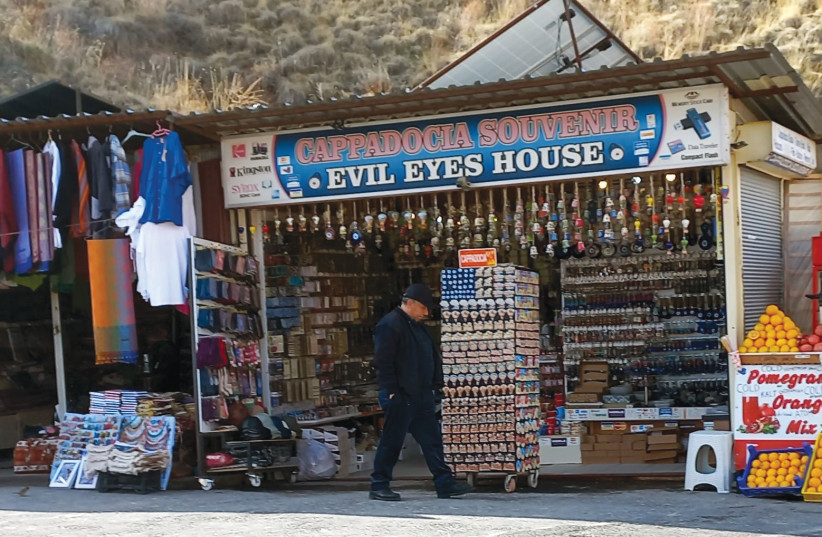Israeli tourism to Turkey is big business. Nearly 800,000 Israelis visited Turkey through November, well ahead of the record 569,000 for all of 2019, before COVID halted global travel.
But in a bid to get us past the resorts of Antalya and the urban charms of Istanbul, the Turkish Tourism Bureau recently took Israeli journalists on a wintertime five-day trip to the Cappadocia region.
I was a member of that group, which had all flight, food, lodging and travel expenses covered. The trip’s highlights were to be downhill skiing, hot air ballooning, historic underground cities, luxury hotels built into limestone cliffs, world-class ceramics and gourmet food.
Not everything happened as planned.
Cappadocia is in central Anatolia, the Asian portion of Turkey. Its history dates back thousands of years to the Hittites and before. It enjoyed a brief period of independence about 2,000 years ago. Cappadocia is marked by wide open expanses, orange and red hillsides, and vistas reminiscent of the American West. Its soft limestone volcanic tuff geology is responsible for fantastical wind-carved shapes that dot the landscape, vast underground cities and innumerable caves.
Over the centuries, the underground cities, some of which extend to eight subterranean levels, housed thousands in times of danger. The Goreme National Outdoor Museum, a UNESCO world heritage site we visited, once was home to a community of early Christians, who built churches with still-visible frescoes.
Today, especially in the tourist town of Urgup (pronounced oor-youp), ancient and newly excavated caves are used as rooms and dining areas in hotels ranging from budget to deluxe.
After a brief overnight in Istanbul, we flew to Kayseri, the capital of the Cappadocia region and another city named after that famous Roman, Augustus. Once we landed in Kayseri’s bus-station-of-an-airport, we piled into a minivan for a day of touring. Most of the time we saw cowboy-country type panoramas. The region stretches more than 150 km. and comprises 5,000 sq. km., nearly a quarter the size of Israel, so if you plan to visit its sites, be prepared to spend time in a car or van.
Our first stop and likely yours if you go with a guide or tour group, was the so-called “Imagination Valley,” clearly a name designed for tourists. Take a short stroll on soft trails and you’ll see all manner of shapes carved over the centuries by wind and rain. Resist your guide’s temptation to tell you that you are looking at camels and elephants and exercise your own creativity.
After lunch (I’ll get to the food in a bit), we headed to Goreme Open-Air Museum. It’s a sprawling complex of caves and tunnels, in which priests and nuns gathered over the centuries for lives of prayer and contemplation – and to protect themselves in times of persecution and attack. Detailed and colorful frescoes dating from the 11th century and before are intact and sport vivid illustrations of St. George and the Dragon, among other saints and religious figures.
Many of the figures had their faces scraped off by Muslims after the Christian era, but one that you can see is St. Onuphrius. The legend of this obscure saint is that Onuphria was a woman who begged God to turn her into a man, so she could avoid being given away in marriage. The fresco of Onuphrius is a stylized nude woman with the face of a bearded man.
The town of Urgup
You’ll probably end the day in Urgup at one of the scores of “cavern hotels.” We stayed at Yunak Evleri Hotel, which is up a narrow, cobblestone alley and literally built into a towering cliff. As with the wind-carved shapes we saw earlier, it possesses a fairytale quality. The rooms are furnished with antique-style four-poster beds, and the walls and ceilings are curved and cavern-like. Yunak is at the upper end of the town’s 50+ hotels and offers a bounteous buffet breakfast that rivals top Israeli hotels’ offerings.
Urgup is a town of 19,000, so it doesn’t have a great deal to offer in terms of nightlife. We were there during the World Cup, and the best place to watch the games was in a coffee shop. Bars don’t have TV screens, and cafés don’t offer beer or liquor, so you must make a choice between the two. You may be able to find live Turkish rock – a little known but unique genre – at Angel bar. It serves the only Turkish beer we could find – Efes – for reasonable prices.
We were supposed to spend the night at Erciyes Ski Mountain but our plans upended in the hope that enough snow would fall in the coming days for us to go on our planned skiing trip. We also had expected to go hot air ballooning. Cappadocia is known for this, and you will see thousands of tourist trinkets in the shape of balloons.
But the day dawned cold and damp, and we headed instead to Kaymakli, home to one of Cappadocia’s largest underground cities. At least 20 such sites have been identified, some of which may have been first excavated in the 8th century BCE, and there are indications that many are connected.
Over the centuries and as recently as the 20th, different communities used them as retreats from harsh weather and to hide from invaders. Despite their depth – as much as 100 meters on eight levels – extensive air vents keep the rooms free of the moisture and humidity found in natural caves.
We walked, crouched and wedged our way through tunnels, down steps and along a below-ground trail for more than an hour through rooms that once housed kitchens, supplies, animals and living quarters. Yellow and orange lighting gave the rooms a fanciful appearance. I was struck by a five-ton circular boulder that our guide said four or five men would roll across the cavern opening in times of danger.
The most dramatic view we enjoyed was from the top of a winding road across a deep ravine from Ortahisar, a 90-meter-high rock-castle in the center of a town, a short drive from Urgup. As we drank steaming hot Turkish coffee on a windy, rainy afternoon, we marveled at the scores of windows and doors cut into the rock and the cliff dwellings that surrounded the castle like supplicants at the feet of a sovereign.
The meals we were served ranged from traditional to “fusion.” Cappadocian cuisine included deep fried sevketi bostan, a thistle native to the region, and Nevzine tatlisi, a dessert pastry that includes dough, tehina and pekmez, a grape-based molasses syrup.
Pastas, in the form of raviolis of different shapes called manti, were another local specialty. We ate stews and casseroles cooked in cast-iron pots and topped with dough baked to a hard crust. Tourist-oriented restaurants made a production of cracking open the tops with a hammer and then pouring the stew into individual bowls. Cappadocians were also proud of their local wines.
Vegetarian and vegan alternatives, salads, and fresh fruits were widely available. Prices for a high-end dinner with multiple courses were about half that of a comparable meal in Tel Aviv or Jerusalem. The same can be said for hotels, entrance fees to attractions and other costs.
For the shopping-inclined, Cappadocia is home to beautiful ceramics. We visited a studio housed in a warren of underground rooms in the town of Avanos and watched craftspeople at their painstaking work. But the good stuff isn’t cheap. Expect to pay about NIS 200 for a small plate.
You’ll notice that I haven’t described what were supposed to be the trip’s highlights – skiing and hot air ballooning. Erciyes Ski Resort, one of Turkey’s largest and situated at the base of a 3,900-meter mountain, was closed for a lack of snow. The hot air ballooning was canceled three days in a row because of high winds and rain.
Here’s my bottom line: I can’t report on whether the skiing and ballooning are as good as promised, but even without them, Cappadocia is interesting. It should be a draw for those interested in history and dramatic scenery.
But the shleppiness of traveling to attractions that sprawl across the region is a challenge. It seems to me that it would be worth visiting if you have already been to Antalya, gone hiking in the countryside and visited coastal beaches.
If you haven’t visited Turkey, however, I would recommend starting with Istanbul, a sprawling and fascinating city of 18 million, with a significant Jewish heritage, deep connections to Israel through its Ottoman past and world-class attractions such as the Hagia Sophia mosque and the overwhelming Grand Bazaar.
Because our skiing and ballooning didn’t materialize, we spent an extra day in Istanbul, where I got a brief taste of those amazing sites. But that’s the subject of a different story.
The writer was a guest of the Turkish Tourism Bureau.


